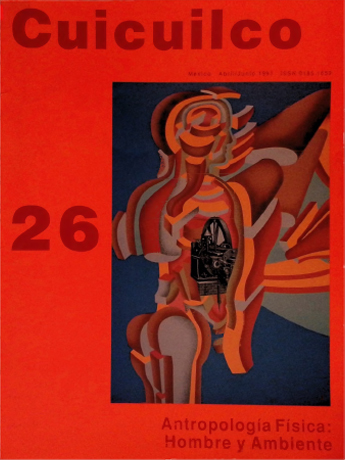Artículos
Publicado 2023-09-13
Palabras clave
- Antropología física,
- Paleoantropología
Derechos de autor 1991 Instituto Nacional de Antropología e Historia

Esta obra está bajo una licencia internacional Creative Commons Atribución-NoComercial 4.0.
Cómo citar
Paleoantropología: treinta años de investigación empírica sobre los orígenes humanos. (2023). Cuicuilco Revista De Ciencias Antropológicas, 9(26), 31-40. https://revistas.inah.gob.mx/index.php/cuicuilco/article/view/19826
Resumen
-
Descargas
Los datos de descarga todavía no están disponibles.
Referencias
- Boaz, N. T. y A. J. Cronin, “Historical Development in Molecular Anthropology", en F. Spencer (ed.), A History of American Physical Anthropology, Academic Press, New York, 1982.
- Boule, M. y H. Vallois, Les Hommes Fósiles, Masson, Frérés et Cié., París, 1956.
- Brauer, G., "A Craniological Approach to the Origin of Anatomically Modern Homo Sapiens in Africa and his Implications for the Appeareance of Modern Europeans”, en Smith y F. Spencer (eds.), The Origin of Modern Humaos, Alan R. Liss Inc., New York, 1984, pp. 327-410.
- Chang, K. C., "Chínese Paleoanthropology", en Annual Review of Anthropology, volumen 6, 1977, pp, 137-159.
- Fernández T., J. L., “Antropología molecular y evolución de hominoidea”, en Estudios de antropología biológica. UNAM, México, 1982, pp. 247-261.
- Gould, S. J., Ontogeny and Philogeny, Cambridge University Press, 1979.
- Holloway, R., "The Cast of Fossil Hominid Brains”, en R. F. Thompson (ed.), Progress in Psichobiology: Reading for "Scientific American", Freeman Co., San Francisco, 1975, pp.19-28.
- Howell, F. C., “Lugar del hombre de Neanderthal en la evolución humana", suplemento de la revista Tlatoani, ENAH, 1962.
- Howells, W.,“Homo Erectus-Who, When and Where: a Survey", Yearbook of Physical Anthropology, volumen 23, 1980, pp. 1-23.
- Hrdlicka, A., Ancient SkeletonsofEarly Man, Lippincott, Philadelphia, 1939.
- Jacob, T., “The Skull Cap of Pithecanthropus Erectus", en American Journal of Physical Anthropology. volumen 25.1966, pp. 243-260. — "Morphology and Paleoecology of Early Man in Java", en R.H. Tuttle (ed.), Paleoanthropology, Morphology and Paleoecology. Mouton, Chicago. 1974, pp. 311-325.
- Johanson, D., Lucy, el primer antepasado de la humanidad, editorial Planeta, México, 1982. — "Algunas consideraciones sobre los orígenes del género Homo", en Duncan, R. y M. Weston, Smith (eds.), La enciclopedia de la ignorancia, Fondo de Cultura Económica, 1986, pp. 281-290.
- Johanson, D. y T. White, “An Assessment of Pliopleistocene Early Hominids , en Science, volumen 203, 1974, pp. 321-330.
- King, M. C„ y A. Wilson, “Evolution of Two Levels in Human and Chimpanzees”, en Science, volumen 188,1975.
- Leakey, AdamAncestors, Penguin Books, San Francisco,1959.
- Lewin, R., La interpretación de los fósiles, editorial Planeta, México, 1990.
- Mayr, E„ “Reflections on Human Paleontology", en F. Spencer (ed.), A History of American Physical Anthropology: 1930-1980, Academic Press, 1982.
- Pilbeam, D., El ascenso del hombre, editorial Diana, México, 1974. — “Miocene Hominoids: Recent Finds and Interpretations", Annual Review of Anthropology, volumen 8, 1979, pp. 333-352.
- Rightmire, G. P„ "Homo Erectus and Later Midle Pleistocene Humans”, en Annual Review of Anthropology. volumen 11, 1988, pp. 239-259.
- Sarich, V. y A. Wilson, “Rales of Albumen Evolution in Primates", en Proc. NationalAcademy of Science , volumen 58, USA, 1962, p.142. — “Inmunological Time Scale for Hominid Evolution", en Science, volumen 58,1968, p. 1200.
- Sipman, P., “¿El eslabón perdido?", en Lo mejor de Geomundo, 1989.
- Smith, F. H„ A. B. Falsetti y S. Me. Donelly, “Modern Human Origins", Yearbook of Physical Anthropology, volumen 32,1989, pp. 35-68.
- Tattersall, I., E. Delson y J. V. Covering, Encyclopedia of Prehistory and Human Evolution, Garland Pub, 1988, pp. 68-84.
- Trinkaus, E., "A History of Homo Erectus and Homo Sapiens Paleontology in America", en F. Spencer (ed.), A History of American Physical Anthropology: 1930-1980, Academic Press, New York, 1982, pp. 261-288.
- Tuttle, R. H., “What's New in African Paleoanthropology?", en Annual Review of Anthropology, volumen 17,1988, pp. 391-426.
- Walker, A. Leakey, R. J. Harris y F. H. Brown, "2.5 Myr Australopithecus Boisei from West of Lake Tukana, Kenya", en Nature, volumen 322, 1988, pp. 517-522.

